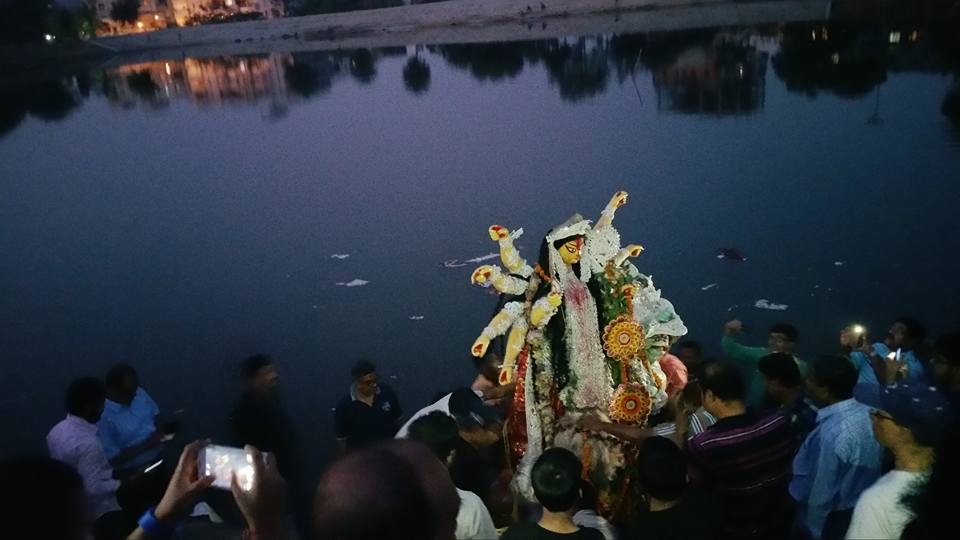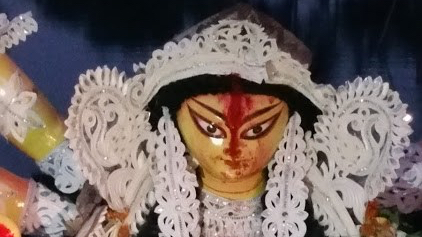Durga Puja holds a significance beyond religious observance in the hearts of Bengalis. Whether one is an atheist or a believer, every Bengali participates in the celebration of Durga Puja with equal enthusiasm. The four days of festivity culminate with the immersion of Maa Durga’s idol into ponds, rivers, and lakes on Dashami, symbolizing her return to Lord Shiva’s abode.
Bijoya, which follows Durga Puja, is a significant and extended celebration in the Bengali culture. It carries the essence of victory, and it’s a time for families and friends to come together, exchange greetings, and celebrate the triumph of good over evil.
As Dashami passes and the immersion of Goddess Durga takes place, a sense of melancholy envelops the hearts of every devotee. The four days of celebration seem to vanish all too quickly. While there may be a hint of sadness as Bijoya Dashami marks the day of bidding farewell to Durga Maa and her children, it is also a joyous occasion.

In Bengali tradition, the term “Bijoya” carries the literal meaning of “Victory.” Therefore, “Shubho Bijoya” signifies “The Auspicious Victory.” Bijoya celebrations commence on the final day of Durga Puja, Vijaya Dashami, and continue until Kali Puja or Diwali. This means that Bijoya festivities span for nearly a month.

“Shubho Bijoya” is a heartfelt Bengali greeting that is used to bid farewell to Goddess Durga at the conclusion of Durga Puja. This phrase conveys good wishes and blessings to everyone, symbolizing the auspicious victory of good over evil and marking the departure of Maa Durga as she returns to her divine abode.
Certainly, when I was a child, sadness was the prevailing and conspicuously evident emotion. We felt a profound sense of melancholy as it marked the conclusion of the eagerly anticipated festival. The excitement that had been building in our young hearts for months was coming to an end.

The immersion (বিসর্জন), or departure of the splendour and magnificence of Maa Durga, signified the return to our everyday routines. It was the moment when we resumed wearing our school uniforms and rushed off to school in the mornings. Now, it’s time to transition back to the standard office routine, with its demands of targets, spreadsheets, presentations, meetings, and so on.

Bijoya was the time when we would excitedly visit various households, seeking the blessings of our elders and eager to savour the Bijoya-special treats they had prepared. Bengali cuisine plays a significant role in the Bijoya celebrations. Special dishes, sweets, and feasts are prepared, and people often invite guests to share in these meals.
It was a delightful ritual to sample a platter of sweets or savoury snacks from each house we visited during our childhood. A fun aspect of this tradition was discreetly rating the houses based on the culinary skills of the kitchen owner, making it a playful and engaging part of the celebration.
Now, as adults, we have Bijoya Sammilani, where all the families come together to exchange greetings, share warm embraces through “kolakuli” (কোলাকুলি), and indulge in the festival’s delectable sweets and sumptuous meals. This modern tradition has streamlined the customs of the past, condensing the period of greetings and celebration to just one day, in contrast to the month-long festivities of yesteryears. The taste spotting is a bygone ritual.
“Kolakuli” is a Bengali term that refers to the act of hugging or embracing. It holds significant cultural and emotional importance in Bengali culture, particularly during festivals and special occasions like Durga Puja and Bijoya.
The act of “kolakuli” signifies warmth, love, and a sense of unity. When people exchange “kolakuli,” they are not just hugging; they are expressing affection, respect, and a sense of togetherness. It is a way of showing joy and happiness, and it’s often done when people meet after a period of separation or during celebrations.
During Bijoya and other festive occasions, “kolakuli” is a way for family members, friends, and acquaintances to come together, express their good wishes, and strengthen their bonds of love and camaraderie. It is a beautiful and heartwarming tradition that adds to the emotional richness of Bengali cultural celebrations.
বিসর্জন মানে মা আসবে আবার ফিরে
খুশিতে থাকুক সবাই তোমায় ঘিরে,
মনকে শুধু বোঝাই তবে
আসছে বছর আবার হবে।
Immersion means Mother will come back again
May everyone be happy around you.
Just keep in mind
It will happen again next year.
আসছে বছর আবার হবে (Asche Bochor Abar Hobe) means it will happen again next year. Next year, Maa Durga will arrive again. Bijoya is a period of celebration, unity, and the renewal of positive virtues. For Bengalis, it’s a time of varied emotions as they convey their respect, thankfulness, and sorrow when bidding farewell to the beloved goddess.
“Shubho Bijoya” encapsulates the sentiment of sending off the goddess with well-wishes, seeking her return in the following year, and celebrating the triumph of positive energy.
Happy Bijoya! Shubho Bijoya! শুভ বিজয়া!


During my recent trip to Kolkata, I didn’t get the chance to witness the immersion as I understand that it was too crowded and my friend was not very comfortable with large crowds 🙂
LikeLiked by 1 person
Thanks Kathleen for your comments and visiting my blog. You have narrated your stories on Kolkata & Durga puja very nicely. I would say that you really missed the immersion…from procession to actual immersion is a grand farewell to the goddess.I wish you witness the immersion during your next visit and I am sure that you would love it as an experience.
LikeLiked by 1 person
Hopefully, one day 🙂
LikeLiked by 1 person
শুভ বিজয়া!
LikeLiked by 1 person
শুভ বিজয়া🙏
LikeLike
আসছে বছর আবার হবে। শুভ বিজয়া!
LikeLiked by 1 person
আসছে বছর আবার হবে।
LikeLike